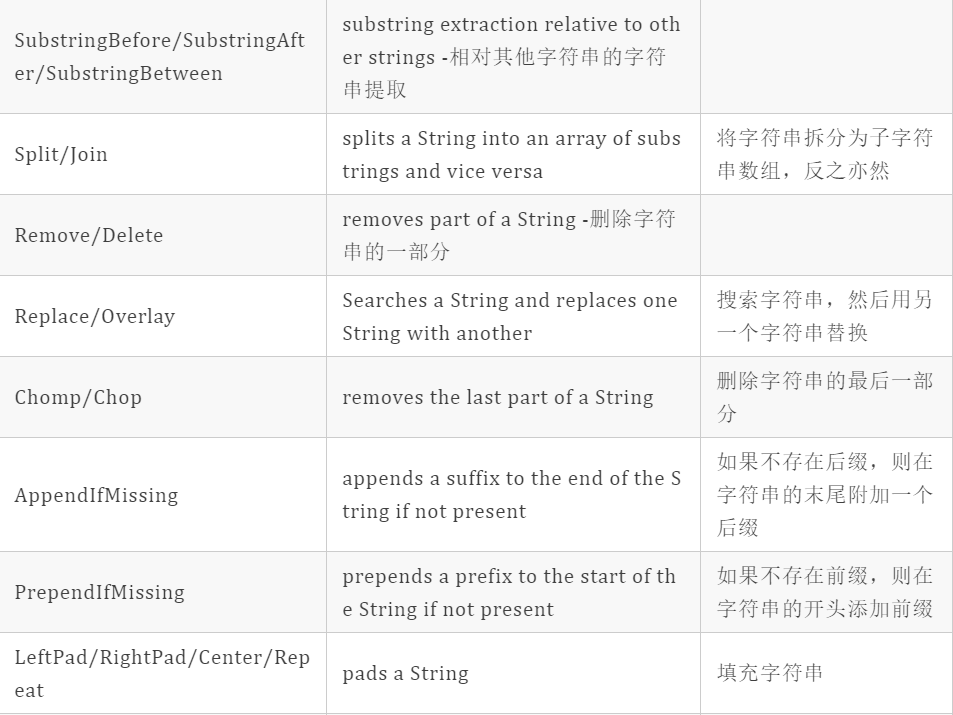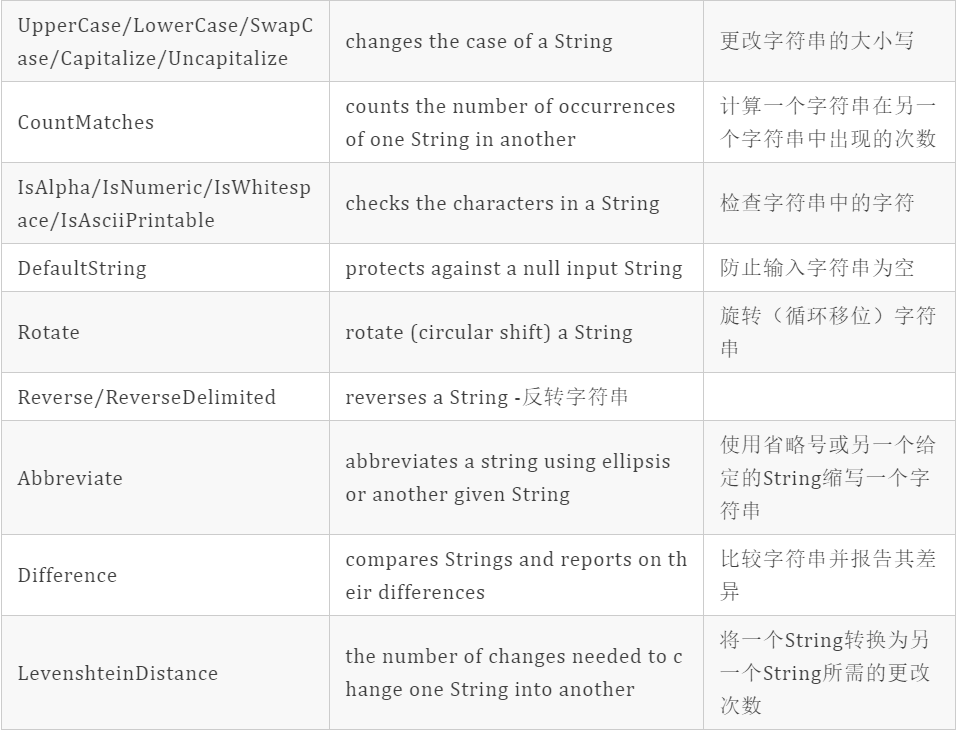目录
-
前言
-
isEmpty 系列
-
isBank 系列
-
StringUtils 的其他方法
前言
isEmpty和isBlank的区别,至少一半人答不上来...
isEmpty 系列
| StringUtils.isEmpty()
是否为空,可以看到 " " 空格是会绕过这种空判断,因为是一个空格,并不是严格的空值,会导致 isEmpty(" ")=false。
-
StringUtils.isEmpty(null) = true
-
StringUtils.isEmpty("") = true
-
StringUtils.isEmpty(" ") = false
-
StringUtils.isEmpty(“bob”) = false
-
StringUtils.isEmpty(" bob ") = false
/**
*
* <p>NOTE: This method changed in Lang version 2.0.
* It no longer trims the CharSequence.
* That functionality is available in isBlank().</p>
*
* @param cs the CharSequence to check, may be null
* @return {@code true} if the CharSequence is empty or null
* @since 3.0 Changed signature from isEmpty(String) to isEmpty(CharSequence)
*/
public static boolean isEmpty(final CharSequence cs) {
return cs == null || cs.length() == 0;
}
| StringUtils.isNotEmpty()
相当于不为空,= !isEmpty()。
public static boolean isNotEmpty(final CharSequence cs) {
return !isEmpty(cs);
}
| StringUtils.isAnyEmpty()
是否有一个为空,只有一个为空,就为 true:
-
StringUtils.isAnyEmpty(null) = true
-
StringUtils.isAnyEmpty(null, “foo”) = true
-
StringUtils.isAnyEmpty("", “bar”) = true
-
StringUtils.isAnyEmpty(“bob”, “”) = true
-
StringUtils.isAnyEmpty(" bob ", null) = true
-
StringUtils.isAnyEmpty(" ", “bar”) = false
-
StringUtils.isAnyEmpty(“foo”, “bar”) = false
/**
* @param css the CharSequences to check, may be null or empty
* @return {@code true} if any of the CharSequences are empty or null
* @since 3.2
*/
public static boolean isAnyEmpty(final CharSequence... css) {
if (ArrayUtils.isEmpty(css)) {
return true;
}
for (final CharSequence cs : css){
if (isEmpty(cs)) {
return true;
}
}
return false;
}
| StringUtils.isNoneEmpty()
相当于 !isAnyEmpty(css),必须所有的值都不为空才返回 true。
/**
* <p>Checks if none of the CharSequences are empty ("") or null.</p>
*
* <pre>
* StringUtils.isNoneEmpty(null) = false
* StringUtils.isNoneEmpty(null, "foo") = false
* StringUtils.isNoneEmpty("", "bar") = false
* StringUtils.isNoneEmpty("bob", "") = false
* StringUtils.isNoneEmpty(" bob ", null) = false
* StringUtils.isNoneEmpty(" ", "bar") = true
* StringUtils.isNoneEmpty("foo", "bar") = true
* </pre>
*
* @param css the CharSequences to check, may be null or empty
* @return {@code true} if none of the CharSequences are empty or null
* @since 3.2
*/
public static boolean isNoneEmpty(final CharSequence... css) {
return !isAnyEmpty(css);
}
isBank 系列
| StringUtils.isBlank()
是否为真空值(空格或者空值):
-
StringUtils.isBlank(null) = true
-
StringUtils.isBlank("") = true
-
StringUtils.isBlank(" ") = true
-
StringUtils.isBlank(“bob”) = false
-
StringUtils.isBlank(" bob ") = false
/**
* <p>Checks if a CharSequence is whitespace, empty ("") or null.</p>
* @param cs the CharSequence to check, may be null
* @return {@code true} if the CharSequence is null, empty or whitespace
* @since 2.0
* @since 3.0 Changed signature from isBlank(String) to isBlank(CharSequence)
*/
public static boolean isBlank(final CharSequence cs) {
int strLen;
if (cs == null || (strLen = cs.length()) == 0) {
return true;
}
for (int i = 0; i < strLen; i++) {
if (Character.isWhitespace(cs.charAt(i)) == false) {
return false;
}
}
return true;
}
| StringUtils.isNotBlank()
是否真的不为空,不是空格或者空值,相当于 !isBlank();
public static boolean isNotBlank(final CharSequence cs) {
return !isBlank(cs);
}
| StringUtils.isAnyBlank()
是否包含任何真空值(包含空格或空值):
-
StringUtils.isAnyBlank(null) = true
-
StringUtils.isAnyBlank(null, “foo”) = true
-
StringUtils.isAnyBlank(null, null) = true
-
StringUtils.isAnyBlank("", “bar”) = true
-
StringUtils.isAnyBlank(“bob”, “”) = true
-
StringUtils.isAnyBlank(" bob ", null) = true
-
StringUtils.isAnyBlank(" ", “bar”) = true
-
StringUtils.isAnyBlank(“foo”, “bar”) = false
/**
* <p>Checks if any one of the CharSequences are blank ("") or null and not whitespace only..</p>
* @param css the CharSequences to check, may be null or empty
* @return {@code true} if any of the CharSequences are blank or null or whitespace only
* @since 3.2
*/
public static boolean isAnyBlank(final CharSequence... css) {
if (ArrayUtils.isEmpty(css)) {
return true;
}
for (final CharSequence cs : css){
if (isBlank(cs)) {
return true;
}
}
return false;
}
| StringUtils.isNoneBlank()
是否全部都不包含空值或空格:
-
StringUtils.isNoneBlank(null) = false
-
StringUtils.isNoneBlank(null, “foo”) = false
-
StringUtils.isNoneBlank(null, null) = false
-
StringUtils.isNoneBlank("", “bar”) = false
-
StringUtils.isNoneBlank(“bob”, “”) = false
-
StringUtils.isNoneBlank(" bob ", null) = false
-
StringUtils.isNoneBlank(" ", “bar”) = false
-
StringUtils.isNoneBlank(“foo”, “bar”) = true
/**
* <p>Checks if none of the CharSequences are blank ("") or null and whitespace only..</p>
* @param css the CharSequences to check, may be null or empty
* @return {@code true} if none of the CharSequences are blank or null or whitespace only
* @since 3.2
*/
public static boolean isNoneBlank(final CharSequence... css) {
return !isAnyBlank(css);
}
StringUtils 的其他方法
可以参考官方的文档,里面有详细的描述,有些方法还是很好用的。
https://commons.apache.org/proper/commons-lang/apidocs/org/apache/commons/lang3/StringUtils.html



往期热门文章:
3、ArrayList#subList这四个坑,一不小心就中招
4、面试官:大量请求 Redis 不存在的数据,从而影响数据库,该如何解决?








 这篇博客详细介绍了 Apache Commons Lang 中 `StringUtils` 类的相关方法,特别是 `isEmpty()` 和 `isBlank()` 系列方法的区别。`isEmpty()` 判断字符串是否为空,而 `isBlank()` 还会检查字符串是否包含空白字符。此外,还提到了 `isNotEmpty()`, `isAnyEmpty()`, `isNoneEmpty()`, `isNotBlank()`, `isAnyBlank()` 和 `isNoneBlank()` 方法,以及它们在处理多个字符串时的行为。这些方法对于字符串验证非常实用。
这篇博客详细介绍了 Apache Commons Lang 中 `StringUtils` 类的相关方法,特别是 `isEmpty()` 和 `isBlank()` 系列方法的区别。`isEmpty()` 判断字符串是否为空,而 `isBlank()` 还会检查字符串是否包含空白字符。此外,还提到了 `isNotEmpty()`, `isAnyEmpty()`, `isNoneEmpty()`, `isNotBlank()`, `isAnyBlank()` 和 `isNoneBlank()` 方法,以及它们在处理多个字符串时的行为。这些方法对于字符串验证非常实用。
















 391
391

 被折叠的 条评论
为什么被折叠?
被折叠的 条评论
为什么被折叠?








